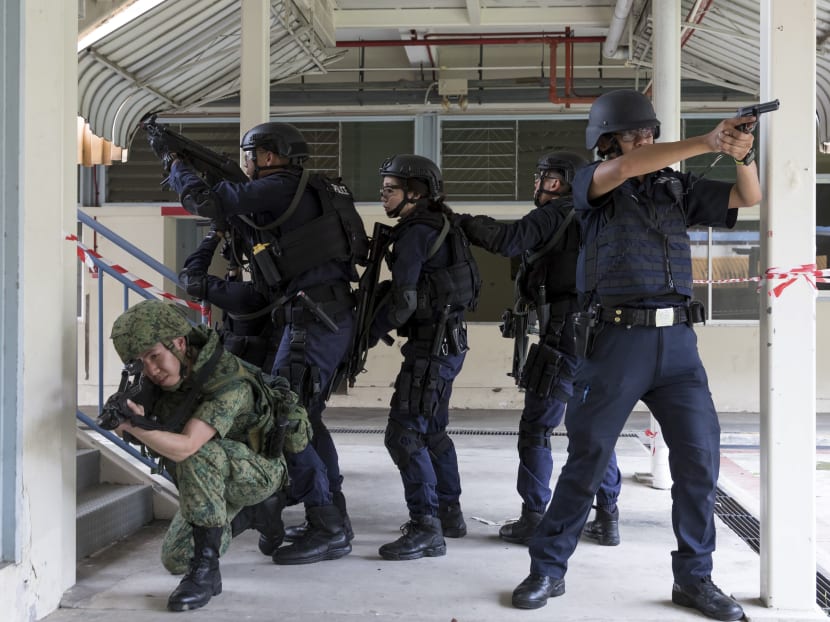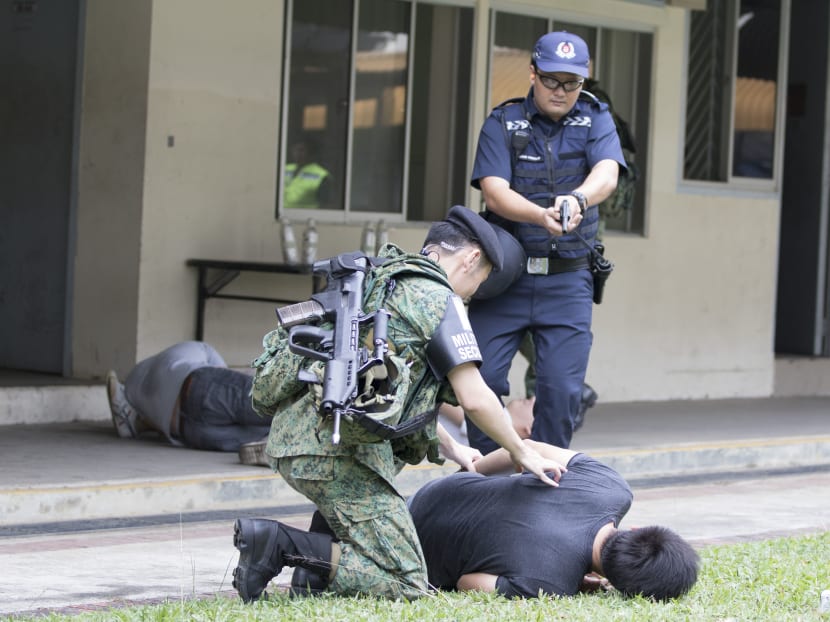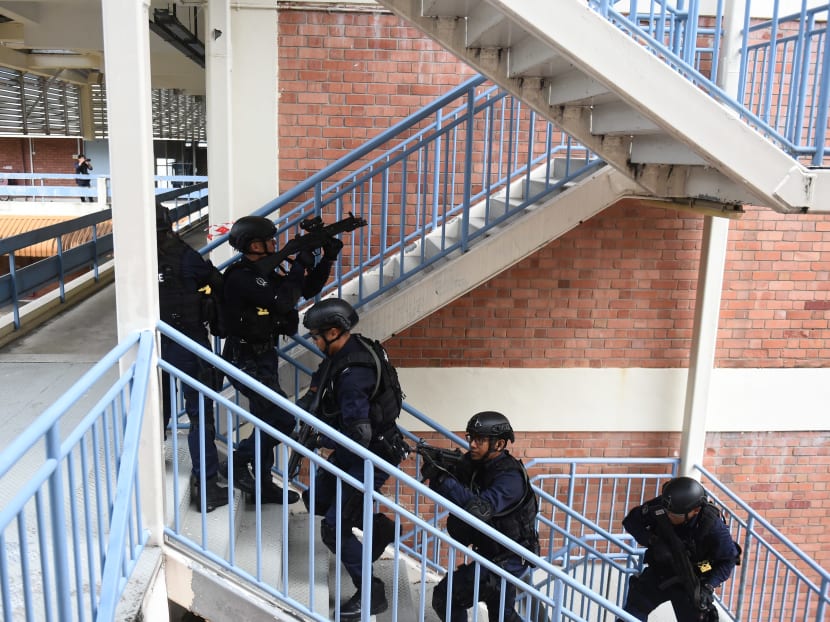All frontline police officers to train with soldiers to prepare for future joint patrols in public
SINGAPORE — A man wielding a knife at a cafe had taken a civilian hostage, and a joint patrol team from the Singapore Police Force and the Singapore Armed Forces (SAF) arrived at the scene to subdue the suspect.

A joint training consisting of SPF and SAF personnel are seen securing an area during an active shooter simulation.
SINGAPORE — A man wielding a knife at a cafe had taken a civilian hostage, and a joint patrol team from the Singapore Police Force and the Singapore Armed Forces (SAF) arrived at the scene to subdue the suspect.

The three-person team comprising one police officer and two soldiers responded like clockwork, even though they were from different authorities and faced some hurdles when using different sets of jargon and procedures.
This is one of the many scenarios that personnel from both security agencies go through during their joint training, which allows SAF personnel to be deployed in public, if needed, alongside the police during major events such as the upcoming 33rd Association of South-east Asian Nations (Asean) Summit.
Plans for routine training between the two forces were first announced in March by Defence Minister Ng Eng Hen and Home Affairs Minister K Shanmugam in Parliament, when both men talked about their respective ministries' preparations to handle terrorist threats.
Mr Shanmugam, who is also Law Minister, said then: “If the scale of (a terrorist) attack is very large, (the Ministry of Home Affairs, MHA) may also ask SAF to provide support to the police as an auxiliary force. Likewise, MHA may also ask other ministries, agencies, like (the Ministry of Health), to support the operations.”
To date, 22,000 soldiers have been trained in homeland security operations, while seven joint training sessions have been conducted since January this year.
All frontline police officers from the six police divisions will undergo the one-day joint training — which may be conducted on a monthly basis — together with active military units (those serving National Service) and operationally ready National Service Army units.
These training sessions will also seek to align the different techniques and tactics used by the two security agencies, as well as the different jargons and commands.
Assistant Superintendent (ASP) Muhammad Hafiz Roslee, who recently went through one such joint training, said that different terms were used by both agencies to ask for rear protection, for example, which led to some miscommunication.
The 29-year-old from the Jurong Police Division said: “We usually train with our police officers and we tend to use a lot of police jargon and code words. When we train with SAF soldiers, (both sides) need to (use) the same language.”
COMBINING STRENGTHS FROM BOTH FORCES
Besides ironing out the differences, the joint training allows both forces to understand and leverage each other's strengths such as firepower, ASP Hafiz said.
Each SAF soldier is armed with a SAR21 rifle, which has a longer shooting range compared with a police officer's handgun.
Corporal First Class Andrew Fung, a fellow trainee and an operationally ready national serviceman from the army, said: "The police are very well-versed in verbal engagements with suspects, so it's about complementing each other’s strength."
The 25-year-old from the HQ 9 Division added that it is foreign for soldiers to operate in a situation where it is not a war-time scenario and the rules of engagement are different.
“Being exposed to this peace-time training gives us the capability to respond to such scenarios should we be called upon,” he said.
Other scenarios in the joint training include responding to rowdy crowds, a suicide bomber and an active shooter who has taken someone hostage.
Lieutenant Colonel Goh Boon Ping, Commanding Officer of the Homeland Security Training Centre, said that during a joint patrol, each member will be taught their roles and responsibilities.
They are also taught how to link up with reinforcements should there be a need for more forces, he added.

Preparations for the joint training took about five months, including lessons learnt from previous collaborations, such as the joint patrols by the police and the army at Changi Airport.
Explaining the reason for pairing two soldiers with one police officer in a joint patrol team, Superintendent Kenny Yeo, Commanding Officer of the Frontline Policing Training Centre, said that this will free up other police officers to respond to other incidents during periods of heightened threat.
He said: “During periods of heightened threat, which will be island-wide, a lot of resources will need to be poured in for (homeland security operations). Other units from the police need to be on a heightened alert to respond to any potential incidents which may affect public security.”
Agreeing, Colonel Vincent Soh, commander of the Island Defence Training Institute, said: “In this resource-scarce environment, it is even more crucial for the different ministries to come together to deal with a threat."
While such joint training between the two forces is not new, it will now be a routine, Colonel Soh added. Joint exercises for those who have undergone joint training may be conducted in the future.









